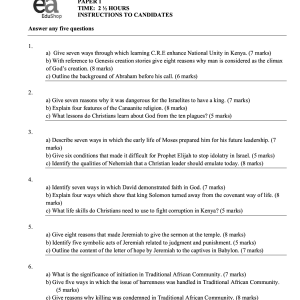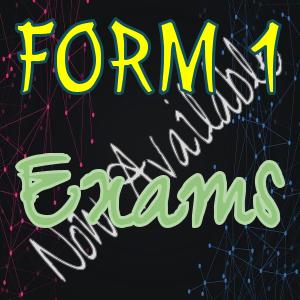Description
Structure of the Document
- Header Information:
- Space for the candidate’s name, admission number, signature, and date.
- An indication of the time allocated for the exam, which is 2½ hours.
- Instructions:
- Clear guidance to answer all questions in the spaces provided.
Content of the Examination
The paper consists of various sections, each designed to test different aspects of business studies. The questions cover a wide range of topics, including:
- Definitions and Concepts:
- Candidates are required to define key terms such as Economics, Production, Entrepreneurship, and Accounting.
- Government and Trade:
- Questions explore how the government can promote trade and the benefits of international monetary organizations like the IMF.
- Business Operations:
- Candidates are asked to outline circumstances under which credit notes are issued and the benefits of warehousing for manufacturers.
- Personal Attributes in Business:
- There are questions focused on the attributes of effective business professionals, particularly in marketing roles.
- Financial Literacy:
- The paper includes tasks related to calculating net worth and understanding financial statements.
- Insurance and Risk Management:
- Candidates must highlight factors influencing insurance premiums.
- Taxation and Individual Impact:
- Questions on the benefits of direct taxes and challenges individuals face in meeting their wants.
- Economic Development:
- Queries about the advantages of delocalization, exploitation of resources, and the roles of development goals.
- Market Dynamics:
- Candidates discuss characteristics of markets and the challenges of unemployment.
- Communication in Business:
- The importance of audio-visual communication and its advantages in conveying messages.
- Distribution Channels:
- Suggestions for effective distribution of agricultural products by farmers.
Marking Scheme
The document also contains a marking scheme that provides answers and outlines the expected responses for each question. This includes:
- Definitions and explanations for business terms.
- Reasoning for government actions in promoting trade.
- Benefits and challenges associated with various business practices.
Conclusion
Overall, the document serves as a comprehensive assessment tool for students studying Business Studies at the secondary level. It covers theoretical knowledge, practical applications, and critical thinking about business concepts, preparing candidates for both examinations and real-world business scenarios.




Reviews
There are no reviews yet.